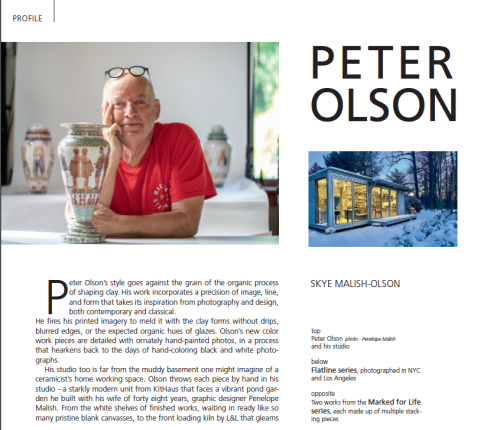
Peter Olson’s style goes against the grain of the organic processof shaping clay. His work incorporates a precision of image, line, and form that takes its inspiration from photography and design, both contemporary and classical.
He fires his printed imagery to meld it with the clay forms without drips, blurred edges, or the expected organic hues of glazes. Olson’s new color work pieces are detailed with ornately hand-painted photos, in a process that hearkens back to the days of hand-coloring black and white photographs.
His studio too is far from the muddy basement one might imagine of a ceramicist’s home working space. Olson throws each piece by hand in his studio - a starkly modern unit from KitHaus that faces a vibrant pond garden he built with his wife of forty eight years, graphic designer Penelope Malish. From the white shelves of finished works, waiting in ready like so many pristine blank canvasses, to the front loading kiln by L&L that gleams while a framed portrait of David Bowie lookson, the couple has worked hard to create anoasis to their own specifications.
Olson began his artistic career as a photographer in the 70s, founding the punk rockmagazine New Sound, along with Malish, and working as a street, sports, and commercial photographer. But these are not old photos from his earlier repertoire. Rather, these are livingand breathing portraits of people taken up to the minute. A series of street photographs taken in Times Square, for example, might make it onto a kiln-fired piece within days of taking the picture.
He is collaging photographs around the cylindrical forms like a kaleidoscope, creating patterns reminiscent of Greek and Roman sculpture, but with everyday people. For the portraits of people, he has a personal ethos that “if you can’t walk up to them and ask permission, it’s not worth the photograph,” and you can see the participation of the subjects come across in the attitudes they exude. Take, for example, his series Marked for Life.
For this series, the artist was interested in people whose bodies are their own canvasses, and who are completely comfortable in their own skin. Their inner selves are at least partially apparent on their physical exterior. After connecting with a Philadelphia tattoo studio he reached out to people who may want to participate in the Marked for Life project. The resulting images were a collaborative effort between photographer and subject, allowing the participant’s personalities to shine through in their portraits.
The overall pattern motifs, when applied,show the influence of French porcelains, while the ceramic forms themselves are an amalgam of many styles. The preferred method of display is as a larger grouping, occasionally a triptych, where the varying heights and diameters can rhyme with one another and create a balanced formation. Within each self-contained form are many-faceting components that host discrete tiers of imagery. Some pieces have removable lids or bases that make them clearly anti-utilitarian, and hide more tiny images.
Olson is notorious for his dislike of “mug” culture. You won’t find him producing fifty mugs for a gift shop. Even for friends and family, they can forget about it, he’s not making you a coffee mug. But if you ask nicely, he might prepare you an urn.
Olson’s works can be found in the permanent collections of the Beth Rudin De-Woody Collection, The Crocker Museum, The Scripps Collection, the Asheville Museum of Art, and the George Ohr Museum among many others. His published monographs are in the permanent collections of The Getty Museum and the Mint Museum. His next exhibition will open at Blue Spiral gallery in 2025. He has shown at the American Museum of Ceramic Art, The Ohr-O’Keeffe Museum of Art, the Asheville Museum of Art, Fuller Craft Museum, The Crocker Museum, AMOCA, and many others.